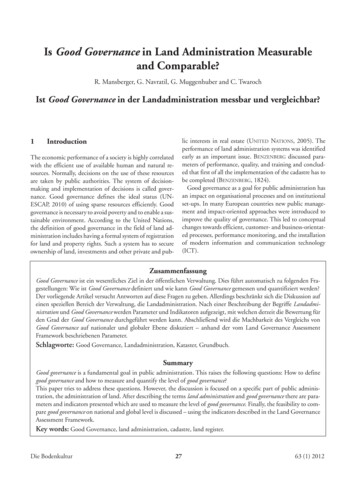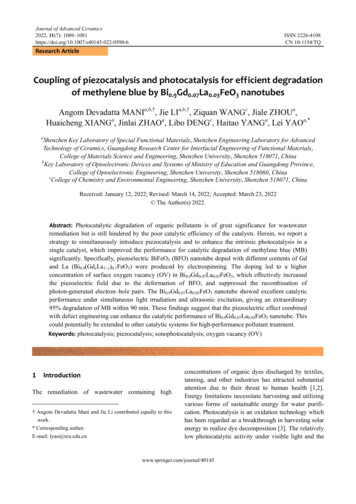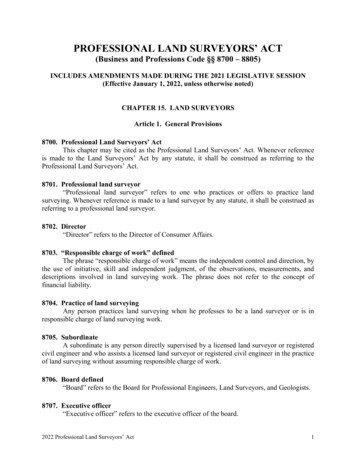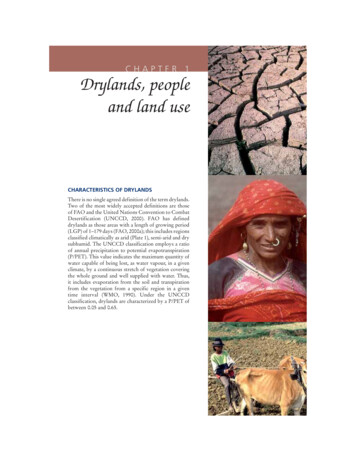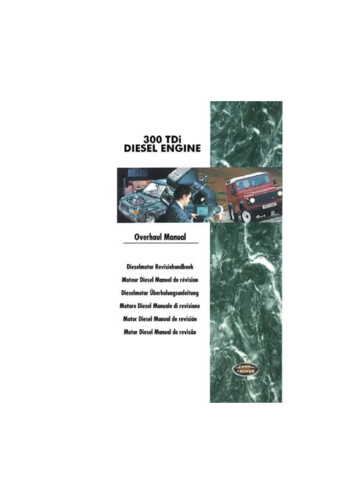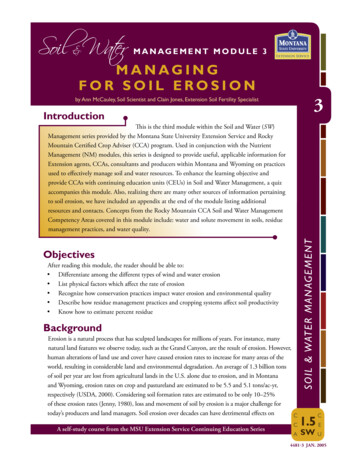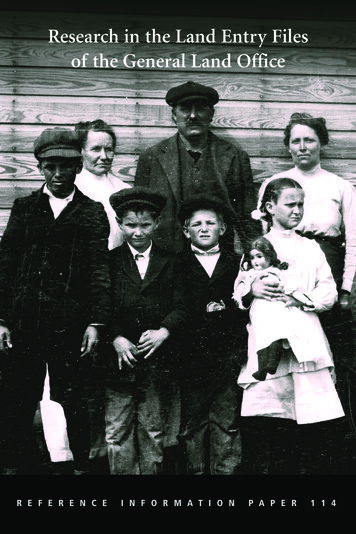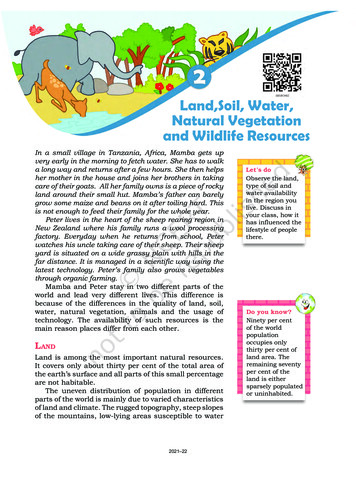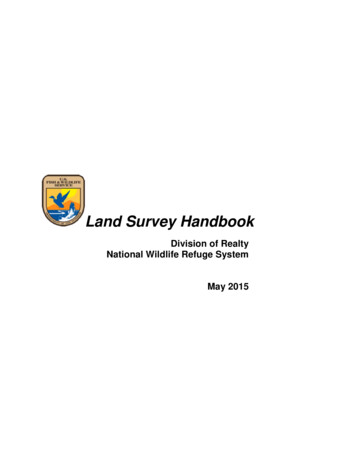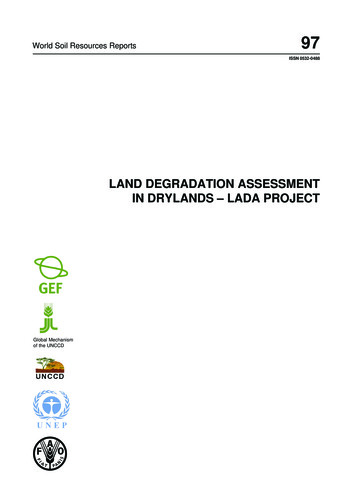
Transcription
World Soil Resources Reports97ISSN 0532-0488LAND DEGRADATION ASSESSMENTIN DRYLANDS – LADA PROJECTGlobal Mechanismof the UNCCD
World Soil Resources ReportsLAND DEGRADATION ASSESSMENTIN DRYLANDS – LADA PROJECTMeeting report23–25 January 2002FOOD AND AGRICULTURE ORGANIZATION OF THE UNITED NATIONSRome, 200297
The designations employed and the presentation of material inthis information product do not imply the expression of anyopinion whatsoever on the part of the Food and AgricultureOrganization of the United Nations concerning the legal status ofany country, territory, city or area or of its authorities, orconcerning the delimitation of its frontiers or boundaries.ISBN 92-5-104797-9All rights reserved. Reproduction and dissemination of material in thisinformation product for educational or other non-commercial purposes areauthorized without any prior written permission from the copyright holdersprovided the source is fully acknowledged. Reproduction of material in thisinformation product for resale or other commercial purposes is prohibitedwithout written permission of the copyright holders. Applications for suchpermission should be addressed to the Chief, Publishing ManagementService, Information Division, FAO, Viale delle Terme di Caracalla, 00100Rome, Italy or by e-mail to copyright@fao.org FAO 2002
Land degradation assessment in drylands – LADA projectiiiExecutive summaryThe goal of the United Nations Convention to Combat Desertification (UNCCD) is theidentification, promotion and implementation of effective responses to land degradation indryland areas. However, the countries participating in this Convention have recognised forsometime now that not enough is known of the nature, extent and severity of the different kindsof land degradation or of their causes on which remedial actions could be based. Presentlyavailable assessment methods have been based on expert estimates and, although valid, are notwell reproducible across countries or regions.The project on Land degradation Assessment in Dryland Areas (LADA) aims to develop andvalidate quantitative, reproducible assessment methods, to make them widely available and todemonstrate and build capacity for their application in the dryland areas of the world.The Global Environment Facility (GEF) funded a Project Development Framework (PDF),enabling UNEP and FAO to initiate the development and validation of methodologies throughpilot activities to be undertaken in two or three countries over a two-year period. A stakeholders’meeting was convened in Rome, 23-25 January 2002, to discuss priorities, strategy and technicalaspects of the LADA work, with emphasis on this initial period.The first plenary sessions discussed papers on various land degradation perspectives and existingnational and regional approaches to land degradation assessment, and reviewed the PDFimplementation strategy. The meeting then dealt with technical and policy aspects in parallelsessions.The technical advisory group explored conceptual and methodological issues in the light of theoutputs specified for the PDF, and reported to the final plenary session on: which information should become available to meet the priorities of the different stakeholders,and how this should be integrated; the process and procedures to be followed; which capacities should be strengthened locally and nationally; how the institutions should build linkages with local communities and among themselves.The Steering Committee session established a provisional Steering Committee comprising GEF/UNEP, FAO, UNCCD, the Global Mechanism of the UNCCD and UNDP; the donor community;national representatives; technical experts, institutions and organisations; the NGO community;regional organisations linked to the UNCCD; as well as observers. The session agreed on termsof reference for the steering committee and provided a summary of its views to the final plenarysession, focusing on policy, information and partnership aspects as well as the geographicalscope of the LADA activities.In its final plenary session the meeting discussed the two reports from the parallel sessions.Recalling that LADA hinges on the underlying principle of attaining global environmental
ivbenefits (in terms of international waters, carbon sequestration and biodiversity), the mainconclusions from the meeting were: The LADA PDF and full project concept were well focused. Methodologies of land degradation assessment should cover social and economic as well asdirect biophysical causes through ensuring a balanced analysis of ecological and economicparameters as well as social dynamics, in order to improve understanding of the complexland-livelihood interactions. Cases of successful improvement of land conditions should be identified and assessed aswell as degradation, in order to focus attention on effective response options. A particular focus should be placed on technical partnerships at all levels and with the widerange of stakeholders, including close feedback with knowledgeable people in localcommunities. Information exchange and capacity building will be underlying thrusts of the project,including methodological development for monitoring and assessment of land degradationand rehabilitation, awareness raising and empowerment at local levels.Women working on landreclamation in NigerFAO/18875/F. Paladini and R.Carucci
Land degradation assessment in drylands – LADA projectvContentsPageEXECUTIVE SUMMARYiiiACRONYMSviMEETING REPORT AND RECOMMENDATIONS1ANNEXES171. WELCOME ADDRESS192. STATEMENT BY A REPRESENTATIVE OF UNEP/GEF233. STATEMENT BY A REPRESENTATIVE OF UNCCD254. MEETING AGENDA AND TIMETABLE275. LIST OF PARTICIPANTS31DOCUMENTS AVAILABLE ON CD-ROMKEYNOTE PAPERSCOUNTRY EXPERIENCES IN LAND DEGRADATION AND REHABILITATIONREGIONAL APPROACHESBACKGROUND PAPER FOR THE PLENARY SESSIONSBACKGROUND PAPERS FOR THE TECHNICAL ADVISORY GROUP SESSIONSSystem requirements to use the CD-ROM: PC with Intel Pentium processor and Microsoft Windows 95 / 98 / 2000 / Me / NT / XPorApple Macintosh with PowerPC processor and Mac OS 8.6 / 9.0.4 / 9.1 / X64 MB of RAM24 MB of available hard-disk spaceInternet browser such as Netscape Navigator or Microsoft Internet ExplorerAdobe Acrobat Reader (included on CD-ROM)
viPresentations and background documents(available on CD-ROM)KEYNOTE PAPERS1.2.3.4.5.6.7.Philosophy and history of land degradation and rehabilitation. M. StockingThe components of land and the LADA project. P. KoohafkanSocio-economic causes of land degradation. C. LilinThe Terrestrial Ecosystems Monitoring System. G. ServinData sources and land degradation assessment methodology. R. OldemanWorld Overview of Conservation Approaches and Technologies. P. LinigerThe role of remote sensing in LADA. D. LantieriCOUNTRY EXPERIENCES IN LAND DEGRADATION AND REHABILITATION8. Some aspects and methodology of desertification monitoring in China. Sun Siheng9. Land degradation and restoration in India – an overview. M. Velayutham10. Land degradation assessment in Brazil. S.R. VieiraREGIONAL APPROACHES11. PAP/RAC erosion mapping methodology in the Mediterranean region.J-C. Griesbach12. Landcare (Australia): a community-based approach to sustainable development.B. Lloyd13. The European land degradation monitoring system. L. MontanarellaBACKGROUND PAPER FOR THE PLENARYSESSIONS14. LADA and its associated activities: an extended implementation strategy. P.J. MahlerBACKGROUND PAPERS FOR THE TECHNICAL ADVISORY GROUP SESSIONS15. Issues for consideration in the technical advisory group and questions to helpstructure the discussions. LADA secretariat16. Shifting views on land degradation. T.F. Shaxson17. From soil conservation to conservation agriculture. J. Benites18. Participatory and multi-stakeholder processes to assess pressures, impacts andidentify response options to land degradation in dryland areas. R. Brinkman19. Land degradation and low external input sustainable agriculture. C. Reijntjes
Land degradation assessment in drylands – LADA projectviiAcronymsCBDCCDCG, EPUNFCCCUSAIDWAICENTWOCATConvention on Biological DiversityConvention to Combat DesertificationConsultative Group on International Agricultural ResearchComité permanent Inter-états pour la lutte contre la sécheresse dans le SahelDepartment for International Development (UK)European Space AgencyEuropean Soil BureauGlobal Environment FacilityGlobal Environmental Outlook (UNEP)Greenhouse gas(es)Global International Waters Assessment.International Fund for Agricultural DevelopmentIntergovernmental Panel on Climate ChangeInternational Soil Conservation OrganisationInternational Soil Reference and Information CentreLand Degradation Assessment in Dryland AreasNational Action Programme (against desertification)Non-Governmental OrganisationPriority Action Programme/Regional Action Centre (UNEP)Project Development FrameworkSouthern African Development CommunitySouthern African Regional Commission for Conservation and Use of the SoilScientific and Technical Advisory PanelTerms of ReferenceUnited Nations Convention on Biological DiversityUnited Nations Convention to Combat DesertificationUnited Nations Environment ProgrammeUnited Nations Framework Convention on Climate ChangeUnited States Agency for International DevelopmentWorld Agricultural Information Centre (FAO)World Overview of Conservation Approaches and Technologies
viii
Land degradation assessment in drylands – LADA project1Meeting report and recommendationsINTRODUCTIONThe goal of the United Nations Convention to Combat Desertification (UNCCD) is theidentification, promotion and implementation of effective responses to land degradation indryland areas. However, the countries participating in this Convention have recognised forsome time now that not enough is known of the nature, extent and severity of the differentkinds of land degradation or of their causes on which remedial actions could be based. Presentlyavailable assessment methods have been based on expert estimates and, although valid, are notwell reproducible across countries or regions.The project on Land Degradation Assessment in Dryland Areas (LADA) aims to developand validate quantitative, reproducible assessment methods, to make them widely availableand to demonstrate and build capacity for their application in the dryland areas of the world.The Global Environment Facility (GEF) funded a Project Development Framework (PDF),enabling United Nations Environment programme (UNEP) and FAO to initiate the developmentand validation of methodologies through pilot activities to be undertaken in two or three countriesover a two-year period. A stakeholders’ meeting was convened in Rome, 23-25 January 2002,to discuss priorities, strategy and technical aspects of the LADA work, with emphasis on thisinitial period.Structure of this reportThis section summarises the structure of the sessions and of this report, and refers to thepresentations, background papers and documents in the Annexes and on the enclosed CD-ROM.Annex 4 comprises the agenda and timetable of the sessions; Annex 5 the list of participants.In the opening session, Ms Louise O. Fresco, Assistant Director-General, AgricultureDepartment, welcomed participants and provided guidance to the discussions (Annex 1). MsA. Tengberg (UNEP/GEF), Mr A. Cissoko (UNCCD) and Ms Ana T. Saez (Global Mechanismof UNCCD) gave introductory statements on behalf of the respective agencies (UNEP-GEFand Global Mechanism statements in Annexes 2 and 3). Parviz Koohafkan summarised theobjectives and organisation of the workshop. This and the next plenary sessions are summarisedin section 2 of this report.The first plenary working session was devoted to seven keynote papers, informing participantson several past and current approaches, methods and systems relevant to land degradationassessment, and a brief discussion. The papers covered.the philosophy and history of landdegradation and rehabilitation (M. Stocking); the components of land and the LADA project(P. Koohafkan); socio-economic causes of land degradation (C. Lilin); the Terrestrial EcosystemsMonitoring System (G. Servin); data sources and land degradation assessment methodology(R. Oldeman); the World Overview of Conservation Approaches and Technologies (P. Liniger);and the role of remote sensing in LADA (D. Lantieri).
2Meeting report and recommendationsIn the next plenary session, country and regional or inter-country experiences in landdegradation assessment and rehabilitation were presented, comprising China (prof. Sun Siheng);Senegal (F. Planchon); Tunisia (M. Farhat and H. Chourabi); India (M. Velayutham); Brazil(S.R. Vieira); the Mediterranean region (J-C. Griesbach); Australia (B. Lloyd); and Europe (L.Montanarella). Mr Koohafkan then presented the project objectives and implementation strategy.The meeting then divided into parallel working sessions. The Technical Advisory Groupdiscussed technical and tactical aspects of the LADA project and related activities. Section 3 ofthis report comprises a summary of their discussions and section 4, issues and recommendations.Five background papers were submitted to the technical advisory group.The sessions on the LADA Steering Committee discussed its terms of reference and itsintended composition, as well as policy and strategic aspects of the LADA project. Section 5 ofthis report comprises the Minutes of their discussions, conclusions and recommendations.The final plenary session (section 6) briefly discussed the reports of the parallel sessionsand adopted the Minutes of the Steering Committee sessions.This meeting report and all documents on the enclosed CD-ROM are also available on-line,with other background information on the project and on the earlier (2000) LADA workshop,at: http://www.fao.org/ag/agl/agll/lada/PLENARY SESSIONSMr K.Yoshinaga, Director, Land and Water Division, FAO, opened the meeting and welcomedthe participants. In her welcome address, Ms Louise O. Fresco, Assistant Director-General,Agriculture Department, provided some guidance for the discussions (Annex 1). Ms A.Tengberg,on behalf of UNEP-GEF, Mr A.Cissoko, on behalf of UNCCD secretariat and Ms A. Saez onbehalf of the Global Mechanism, traced the genesis of the project to this stage and theirexpectations with regard to the outputs during the first two years (Annexes 2–4).It was expected that LADA would build partnerships with other ongoing regional and globalinitiatives such as the Millennium Assessment and the National Action Plans of countriesparticipating in the UN Convention to Combat Desertification. At the same time, the need forcapacity building of the technicians and stakeholders of land management was stressed. Thefocus on global environmental implications (international waters, biodiversity and climatechange, notably carbon sequestration/GHG emissions) was emphasised and, in this regard,attention was drawn to the cross-cutting issues across the UN Convention on Biological Diversityand the UN Framework Convention on Climate Change and its International Panel on ClimateChange. The need for a linkage between regional networks on desertification monitoring(particularly TPN1 in Asia) and LADA was emphasised.The objectives and practical organisation of the Workshop were explained by Mr P.Koohafkan and the agenda of the workshop (Annex 4) was adopted.During the second plenary session, chaired by Mr P. Koohafkan, seven keynote papers werepresented (documents 1–7 on the CD-ROM), informing participants on several past and currentapproaches, methods and systems relevant to land degradation assessment, and a brief discussion.The papers covered:1. The philosophy and history of land degradation and rehabilitation (M. Stocking)
Land degradation assessment in drylands – LADA project32. The components of land and the LADA project (P. Koohafkan)3. Socio-economic causes of land degradation (C. Lilin)4. The Terrestrial Ecosystems Monitoring System (G. Servin)5. World Overview of Conservation Approaches and Technologies (P. Liniger)6. Data sources and land degradation assessment methodology (R. Oldeman)7. The role of remote sensing in LADA (D. Lantieri).Mr Koohafkan then presented the global scenario of the state of land and water resources,the objectives of this stakeholders’ meeting and the implementation strategy of the PDF-Bphase of the LADA project.The main objectives of the full LADA project are: To develop and implement strategies, tools and methods to assess and quantify the nature,extent, severity and impacts of land degradation; To build national, regional and global assessment capacities to enable the design and planningof interventions to mitigate land degradation.The objectives of the PDF-B phase of the LADA project are to develop and test novelintegrated approaches and methods for assessing land degradation in dry areas for applicationin the full LADA project. Specifically this phase is to: Establish an International Technical Steering Committee with representatives of FAO, UNEP/GEF, and UNCCD Secretariats, donors, NGOs and key countries and technical experts onland degradation. Carry out a number of reviews and syntheses on, among others: data sources and assessmentmethods at different geographical scales; on key factors and indicators on land degradation;on the link between biophysical and socio-economic data and their combined effect on landdegradation; on the institutional capacities in pilot countries; on the development ofpartnership modalities and cofinancing sources (the latter two in close cooperation withUNCCD). Carry out a number of thematic studies, partly generic and partly local, on links betweenland degradation and the economic valuation of land, the influence of macro politics, theissue of incremental costs and global benefits, the use of participatory approaches. Develop, test and revise land degradation assessment methods in 2 to 3 pilot countries. Develop a network on land degradation involving all stakeholders to test and discuss theproposed novel approaches. Set up a LADA Web site and disseminate information. Enhance capacity development through the organization of regional workshops. Develop a cofinancing strategy together with executive partnership to implement the fullLADA project. Develop a full LADA project document.In a brainstorming discussion on the keynote papers it was noted that lessons from pastexperiences and studies and a stock-taking review should assist in filling the gaps. Pilot studiesand thematic reviews would lead to the assessment of degradation, but also to setting prioritiesfor rehabilitation and monitoring the pace and trends of degradation. Mr Shaxson emphasized
4Meeting report and recommendationsthat land degradation concerns sustainability of livelihoods. Manipulating water retention, soilporosity and biological activities of the soil in a positive way is crucial for soil recuperationand resilience against soil degradation. Mr Pretty remarked that the multi-functional soil servicesin farming systems should be kept in view for promoting attention to soil health. Ms. Farvaremphasised the importance of community-driven projects as the best approach for landmanagement programmes.Country experiences in land degradation assessment and rehabilitation were presented byrepresentatives of China, Senegal, Tunisia, India and Brazil, demonstrating the variety of methodsand approaches to land degradation assessment and rehabilitation actually in use. This wasfollowed by overviews of regional approaches in the Mediterranean Region (Priority ActionProgramme/RAC), the European Union (The European Soils Bureau) and Australasia (LandcareOrganisation, Australia).TECHNICAL DISCUSSIONSThe Technical Advisory Group explored conceptual and methodological issues, in the light ofthe outputs specified for the PDF-B. The Chair provided a brief introduction and an indicativeoutline of issues and questions requiring consideration. Further background papers submittedto the group dealt with shifting views on land degradation; soil conservation and conservationagriculture; participatory and multi-stakeholder processes; and low external input agriculture.The very broad scope of the mandate for the two half-days of discussion precluded attemptsto address the wide range of issues in depth or to discuss working modalities in detail. It wassuggested that an electronic discussion be opened among participants to further develop specifictechnical issues after FAO will have made available a draft procedure and work plan. This willallow a wide range of expertise and partnerships to contribute to the development of specificaspects of the LADA programme.The hazards of working along the lines of one implicit paradigm (market liberalisation) andusing a relatively mechanical concept (the pressure-state-response model) was raised indiscussion. It was agreed that complementary approaches will be required to provide a balancedanalysis – including ecological and economic parameters as well as social dynamics – in orderto do justice to the complex situation on the ground. This includes the cultural, social, economic,policy, institutional, physical and technological interactions and the diverse nature of the rangeof stakeholders –particularly land users and their communities– and decision-making processes.The Group pointed out the wide range of information and issues that would need to be exploredfrom global to local levels.It was recalled that LADA hinges on the underlying principle of global environmental benefits(in terms of international waters, carbon sequestration and biodiversity). It was noted thatdegradation assessment should look at positive aspects such as stability, resilience and equityas well as at negative trends, it should make reference to specific agro-ecological/farming/landuse systems (for example pastoral, rainfed and irrigated systems) and also consider socialdynamics such as social organisation and self-empowerment (e.g. participation and decisionmaking).In reviewing information issues a particular focus was placed on pilot sites and partnershipwith knowledgeable people in local communities, as this, it was felt, would minimise risks of
Land degradation assessment in drylands – LADA project5misleading mechanistic analyses and assumptions. It was suggested that the list of issues andrecommendations should be provided to CCD committees in the pilot countries with a view toobtaining feedback from different levels and stakeholders (local to national) that would helpguide LADA development.There was general agreement that the work should be based on existing, proven technologiesand approaches of assessment and development, and that testing and validation should focuson their applicability and effectiveness for LADA. The five groups of capital, as used in thesustainable livelihoods concept (natural, human, social, physical, and economic), were felt tobe a useful basis for structuring and analysing the several kinds of information to be collected.Four categories of issues and questions were discussed by the Technical Advisory Group: Which information should become available to meet the priorities of different groups ofstakeholders (global, including GEF and the Conventions; national, both Governments andgovernmental and other institutions; and local authorities, farmers’ associations and civilsociety), and how should such information be integrated? Which process and procedures should be followed in implementing the PDF-B and guidingLADA? Which capacities should be strengthened, locally; at subnational and national levels andregionally? Linkages: How would the institutions work with each other and together with localcommunities or land users’ associations?InformationIt was noted that the assessment would cover two complementary general kinds ofinformation, with dissimilar characteristics and modes of aggregation and generalisation: a)stratified or quantitative outputs and b) conceptual, issues-based information which is generallymore qualitative, complex and multifaceted.a. Stratified or quantitative outputs, in large part geo-referenced (map-type), such as degradationtype, severity and trends, land cover and use, soils information, AEZ and hydrological data.For these, a choice of well-tested acquisition, aggregation and interpretation methods isavailable, and the meeting discussed the merits of two contrasting approaches. Either, mappingthe various elements of the desired variables, and then tuning their interpretation, takinginto consideration interactions, on the basis of more in-depth study in the field. Or, firststudying the operative mechanisms and impacts and then generalising the information usingmapping techniques.Besides mapping and stratified sampling, there are examples of random and grid-basedsampling which could provide information on those variables that have proved most useful.Examples include the US Natural Resources Inventory, where local sites reportedly locatedat random have been visited and revisited every 5 - 10 years; and the 16 km2 monitoring gridin the EU that has 20 years of calibrated datasets. The value of models was also recognisedto make better predictive use of observed data, for example, on land cover change and onlinks between above- and below-ground carbon.
6Meeting report and recommendationsPast surveys, both remote and on the ground, have produced much information that may beusable and relevant for the identification of time trends. Examples include the large collectionof aerial photographs of different dates, and maps and reports by the Soil Survey Sectionand the Land Husbandry Branch in Malawi; and information obtained by the membercountries of the Southern African Regional Commission for Conservation and Utilisationof the Soil (SARCCUS).b. Qualitative, multi-faceted information, which should be acquired through participatorydialogue and exploration, jointly by a local or national LADA team with knowledgeablepeople in local communities representative of significant areas in each country. This wouldinclude information and knowledge on: the reasons underlying observed land degradationstatus and historic trends; on land use and management practices; and on food security,livelihood and coping strategies of different social groups; as well as identification of possibleresponse options (taking into account the socio-economic, institutional and infrastructureconditions, and the local or wider constraints that would need to be overcome to make aneffective response possible). Such information, linked with the stratified or quantitativeinformation for the same area, would need to be aggregated and distilled into a form usefulto national decision-makers and eventually, international fora, for example CCD and CBDmeetings. During the pilot phase, methods to link such representative local information,issues and options to national policy issues should be developed and tested.On the question of how LADA could meet the interests and priorities of local land users,the discussion identified the need to enable and empower communities to look at and analysetheir resources, conditions and objectives in relation to wider environmental concerns, and tohelp them look at their longer-term and communal interests and opportunities. In this regard,capacity building and conflict resolution mechanisms were considered important. Participatoryrural appraisal and other participatory diagnostic methods supported by a multi-disciplinaryteam would also be essential to better understand constraints, opportunities and perspectives ofthe range of local stakeholders (including for example, local and wider power relations).Immediate feedback of the results of any interpretation by the team to the local counterparts isconsidered a prerequisite to build trust, to retain interest and empower those holding localknowledge, to strengthen local stewardship mechanisms and support continued stakeholdercooperation. Once a LADA method of participatory diagnosis will have been tested and validated,appropriately trained teams including members from an advisory or extension service and, forexample, a soil survey institute could extend the coverage over more sites in a country.Discussing what kinds of information would be useful to global stakeholders, the meetingrecognised that the GEF process, for example, should be served by information on the linksbetween land degradation or rehabilitation and global environmental benefits, in particular inregard to international waters, carbon sequestration (above- and below-ground) and biodiversity,including soil biodiversity.Various biophysical and socio-economic examples of indicators were discussed, applicableat different resolutions (scales). Emphasis was placed on water as a major consideration in land resources degradation,including surface, soil and groundwater and hydrological regime. Suggested indicators closelyrelated to land degradation and its causal factors were, inter alia: streamflow regime inrelation to the rainfall regime; water quality (especially solids and nutrient charges) (ref.Global Plan of Action on Protection of marine based environments from Land basedactivities); flooding and drought frequency and hazard; as well as use of wastewater indryland irrigation (e.g. as an indicator of salinisation risk).
Land degradation assessment in drylands – LADA project7 The presence and severity of soil crusting, which may even be recognisable by some formsof remote sensing, and a selection of other erosion indicators (ref. Stocking Field Assessmentof Land Degradation) including those of wind erosion, and indicators of soil biologicalactivity (ref. GEF Tropical Soil Biodiversity and Fertility Programme-TSBF). Ground cover data (ref. FAO Africover data), as well as the two decades
The project on Land degradation Assessment in Dryland Areas (LADA) aims to develop and . Apple Macintosh with PowerPC processor and Mac OS 8.6 / 9.0.4 / 9.1 / X . Mr A. Cissoko (UNCCD) and Ms Ana T. Saez (Global Mechanism of UNCCD) gave introductory statements on behalf of the respective agencies (UNEP-GEF
